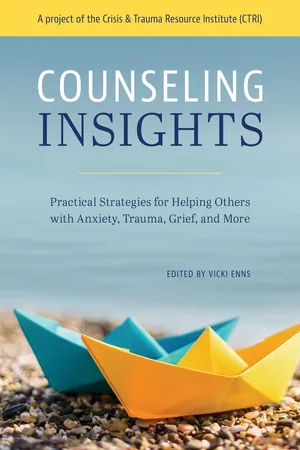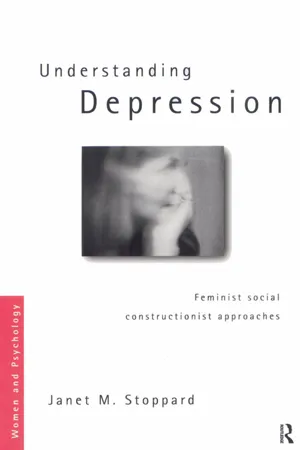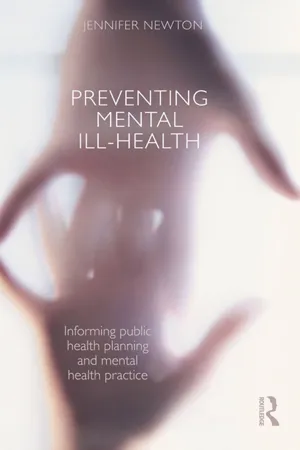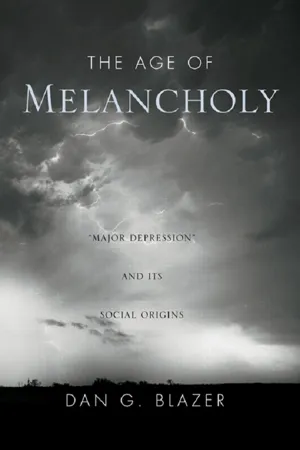Psychology
Depression
Depression is a mental health disorder characterized by persistent feelings of sadness, hopelessness, and a loss of interest in activities. It can impact a person's thoughts, emotions, and physical well-being, often leading to difficulties in daily functioning. Symptoms may vary in severity and duration, and treatment typically involves a combination of therapy, medication, and lifestyle changes.
Written by Perlego with AI-assistance
Related key terms
8 Key excerpts on "Depression"
- eBook - ePub
- Alessandra Lemma(Author)
- 1996(Publication Date)
- SAGE Publications Ltd(Publisher)
Depression is one of the most common psychological conditions and is a normal part of living in view of the losses and disappointments that we all encounter at different stages of the life-cycle. Moreover, as Rippere (1994) points out, because most people who are referred for therapy are depressed to a degree, the dividing line between a depressed and a non-depressed client is largely hypothetical. The term ‘Depression’ itself refers to a heterogeneous set of phenomena, ranging from a normal mood, which is common and probably affects most of us at some point in our lives, to a more severe affective state. Whereas most people may become mildly depressed in response to certain events in their lives only a few react with a severe Depression (Gotlib and Hammen, 1992). Diagnosable Depression may thus be related to some underlying vulnerability of a biological and/or psychological nature which may be triggered by external factors.The central features of all depressive conditions include emotional, motivational, cognitive and psychomotor changes as follows:Emotional manifestations- sadness
- anhedonia (loss of pleasure from one’s usual activities)
- tearfulness
- hopelessness
- feelings of guilt
- feelings of worthlessness
Motivational manifestations- increased dependency
- low energy
- fatigue
- apathy
- poor concentration
- loss of interest
Cognitive manifestations- negative expectations
- negative self-concept
- exaggerated view of problems
- attribution of blame to self
- difficulty making decisions
- suicidal ideation
- thoughts about death itself
- abnormal preoccupation with bodily illness
Psychomotor manifestations- disturbances in appetite and/or weight (increased or decreased)
- disturbances in sleep rhythm (difficulty in ‘getting off’ to sleep, frequent waking or hypersomnia)
- reduced libido
- early waking
- diurnal variation in mood (worst in the morning)
Bodily manifestations- irregular menstrual cycle
- amenorrhoea (cessation of menstruation)
- constipation
The syndrome of Depression (i.e. the cluster of symptoms associated with Depression) is defined in DSM-IV as depressed mood along with a set of additional symptoms, persisting over time and leading to disruptions and impairments in functioning. DSM-IV gives the following criteria for a major depressive episode. Five or more of the following symptoms need to be present during a two-week period (at least one of the symptoms is either depressed mood or loss of interest or pleasure). - eBook - ePub
Counseling Insights
Practical Strategies for Helping Others with Anxiety, Trauma, Grief, and More
- Vicki Enns(Author)
- 2018(Publication Date)
- ACHIEVE Publishing(Publisher)
CHAPTER FOUR Depression By Sheri CoburnTHE WORD Depression GETS THROWN AROUND A LOT . SOCIALLY, THE word has become an overused synonym for sad, annoyed, frustrated, or simply disappointed. People often make offhanded comments like “I am so depressed that sweater hasn’t gone on sale,” which shows little thought or regard for those who bear the true weight of the word. The flippancy of its use can distract from the intensity of the lived reality of Depression and can undermine those who have an intimate connection to it.The reality of Depression is that it is often all-consuming. It can steal the joy out of things once loved by the sufferer, alter perception of self and others, and, at its worst, manipulate a person into planning for the relief anticipated from death. Depression is calculating, vindictive, and strategic. It thrives when left unattended and unmanaged (Strosahl & Robinson, 2008).Depression symptoms can arise around adverse circumstances or overwhelming periods in one’s life. These result in what is known as situational Depression, which can either be short-lived or continue over a long period of time, especially if additional stressors arise during the recovery period.In contrast, a person may have persistent emotional, cognitive, and behavioral clinical Depression patterns linked to chemical changes in the brain, known as clinical or major Depression. These changes are influenced by neurobiology, as well as by external stressors and other contextual factors.For both situational and clinical Depression, recurrent episodes of symptoms increase a person’s vulnerability to subsequent and more ingrained patterns if left untreated. People who have more persistent and major episodes of Depression throughout their lives may need multiple layers of treatment that address biochemical, cognitive, social, and emotional symptoms. Depression is more likely to show up when a person has had experiences of early life adversity or experiences of trauma (Schalinski et al., 2016). - eBook - ePub
Psychopathology
Research, Assessment and Treatment in Clinical Psychology
- Graham C. Davey(Author)
- 2021(Publication Date)
- BPS Blackwell(Publisher)
failures. Experiences such as losing a job or the death of a loved one are likely to trigger periods of sadness, lethargy, and rumination. Similarly, failures—such as failing an exam or failing to persuade someone you like to date you—can also lead to periods of hopelessness and the fostering of negative cognitions associated with pessimism and self‐doubt. Nevertheless, most of us can shake off these feelings within a few days or weeks and get on productively with life. For others, however, the symptoms of Depression may linger and spread to all aspects of their lives—emotional, behavioural, cognitive, and physical—and this can result in diagnosable bouts of Depression that are debilitating enough to prevent an individual from living normal day‐to‐day lives. In extreme cases, the symptoms of Depression can develop even without the occurrence of a precipitating life event, such as a loss or a failure, and will often persist for much longer than would be expected following a loss such as a bereavement.Depression A mood disorder involving emotional, motivational, behavioural, physical and cognitive symptoms.Mania An emotion characterised by boundless, frenzied energy and feelings of euphoria.bipolar disorder A psychological disorder characterised by periods of mania that alternate with periods of Depression.Depression is the prominent emotion in mood disorders, but it can often be associated with its opposite—namely mania. Mania is an emotion characterised by boundless, frenzied energy and feelings of euphoria. As we shall see later, individuals who have a bipolar disorder frequently oscillate between deep Depression and frenetic mania.Depression involves emotional, motivational, behavioural, physical, and cognitive symptoms. The emotional experiences of depressed individuals are usually restricted to negative ones and these are often described as ‘sad, hopeless, miserable, dejected, and discouraged’. Such individuals are often close to tears and have frequent crying episodes. Only very rarely do depressed individuals report experiencing pleasant or positive emotions, they often exhibit a loss of sense of humour and rarely display positive facial expressions (Sloan, Strauss, & Wisner, 2001). Anxiety is also commonly experienced with Depression, which suggests that many sufferers may experience simultaneously a range of negative emotions (Bakish, 1999) that may be reflective of a single underlying symptomatology. Depressed individuals exhibit a range of motivational deficits, and these include a loss of interest in normal daily activities or hobbies. They exhibit a lack of initiative and spontaneity, and frequently report ‘not caring anymore’ and not getting pleasure from activities that they previously enjoyed. This lack of initiative may manifest itself initially in social withdrawal (depressed individuals regularly report wanting to stay where they are and to be left alone), and appetite and sexual desire can also be significantly reduced. Depressed individuals exhibit a number of behavioural symptoms, including a slowness of speech and behaviour generally (Joiner, 2002). They become physically inactive, stay in bed for long periods, and reports of decreased energy, tiredness, and fatigue are common. Even the smallest of tasks seem to require substantial physical exertion. Depression also has an embodied element to it. People who experience Depression also exhibit characteristic postures and movements that are an integral feature of their Depression experience, and the role of these embodiments is discussed more fully in Focus Point 7.1 . Physical s - eBook - ePub
Understanding Depression
Feminist Social Constructionist Approaches
- Janet Stoppard(Author)
- 2014(Publication Date)
- Routledge(Publisher)
Definitional debatesDOI: 10.4324/9781315787961-3In the previous chapter, I discussed different meanings of the term Depression and drew a distinction between the way mental health professionals and researchers use this word and how it is used by ordinary people. When used by professionals and researchers, the word Depression normally means depressive disorder or depressive symptoms (these terms were defined in Chapter 1 ). In this chapter, I discuss these two ways of conceptualizing Depression in more detail, considering how they are employed in practise and also examining the assumptions on which they are based. An issue of particular interest to researchers and professionals (especially those in North America) is the need to distinguish between depressive disorder and depressive symptoms. Although these two ways of conceptualizing Depression can be differentiated, they also have features in common which distinguish them from a third way of understanding Depression, depressive experiences. When Depression is understood in this way, the perspective shifts from that of researchers and professionals to that of women who are depressed, with a focus on subjective experiences.In the theoretical approaches to Explaining Depression in Women discussed in Part II , Depression has been conceptualized as either depressive disorder or depressive symptoms. If considered at all, women’s depressive experiences serve mainly as a resource used by researchers and professionals for diagnosing depressive disorder or for establishing the presence of depressive symptoms. Thus women’s depressive experiences are not of direct interest in most positivist approaches to research and professional practise. From a feminist perspective, in contrast, women’s reports of their depressive experiences are viewed as having meaning in their own right. Such accounts provide a basis for exploring subjectivity, specifically women’s depressive experiences and their understandings of Depression, and how both are shaped by discursive conditions within the sociocultural context of their everyday lives.1 - eBook - ePub
Preventing Mental Ill-Health
Informing public health planning and mental health practice
- Jennifer Newton(Author)
- 2013(Publication Date)
- Routledge(Publisher)
DepressionThose who have experienced a marked Depression describe first and foremost their lack of energy, or desire to be bothered to do anything. Even talking may seem to take effort. Instead there might be a desire to retreat to bed, to sleep and perhaps to cry. On the other hand, sleep may be difficult: the person may wake in the early mornings and lie for long hours unable to get back to sleep, feeling particularly low at this time. Appetite and enjoyment of food can also sometimes be affected.Few people with Depression feel good about themselves or see anything to which to look forward. No point in studying, as would not get to college anyway. No point in trying to complete those extra tasks at the office, as stand no chance of being considered for that more senior position at work. But the depressed person may also have much suppressed anger, resentment, fear or anxiety, which can be reflected in some agitation and in irritable behaviour, perhaps snapping at those close to them (see Gilbert, 2007). In fact, a mixture of anxiety and Depression is even more common than Depression alone (see Chapter 3 ). The experience of most or all of the symptoms described above for at least two weeks would lead to a diagnosis of major Depression on both the ICD and the DSM. On the ICD, the diagnosis would describe it as moderate or severe, based on the number of symptoms.At the other end of the range, a mild Depression has a fairly ordinary quality about it that most of us understand, as we have all experienced at least the short, transient feelings of misery, apathy and hopelessness which are a prominent part of the picture. But if these feelings endure – and some people have low–level symptoms on and off for years – then the DSM and ICD might label this ‘dysthymia’ (if two years or more). It is possible – indeed quite common – to experience a major Depression on top of dysthymia (Hammen, 1997). - eBook - ePub
Psychopathology
History, Diagnosis, and Empirical Foundations
- W. Edward Craighead, David J. Miklowitz, Linda W. Craighead(Authors)
- 2017(Publication Date)
- Wiley(Publisher)
Chapter 7Depressive DisordersW. Edward Craighead Daniel N. Klein Charles F. Gillespie Lorie A. Ritschel Katherine E. PhillipsDescriptions of individuals suffering from depressive disorders have been remarkably similar for centuries, though the designation of specific criteria for diagnosis of these disorders has been relatively recent. Descriptions of Depression exist in literary references across the world and throughout history; one of the very earliest examples is the biblical description of Job's Depression.In U.S. history, a number of well‐known individuals from all walks of life have suffered from Depression. These include Abraham Lincoln, who suffered at least two depressive episodes; William James, one of the founders of psychology and the primary force in establishing it as a discipline at Harvard University in the 1890s; actors such as Anne Hathaway, Jon Hamm, and Brad Pitt; J. K. Rowling, author of the world‐renowned Harry Potter book series; astronaut Buzz Aldrin, who was the second human to walk on the moon; television personalities such as Drew Carey, David Letterman, and newscaster Mike Wallace; musicians such as Beyoncé Knowles, Bruce Springsteen, and Sheryl Crow; and athletes such as Delonte West, an NBA basketball player, and Amanda Beard, a gold‐medal‐winning Olympic swimmer. Although each had a somewhat different experience and course of the disorder, the symptoms and defining characteristics were remarkably similar.It is fairly common to hear someone remark, “I am so depressed,” because almost everyone has experienced a sad mood, one of the primary indicators of clinical Depression. Most often, however, this comment describes transient feelings of sadness, dysphoria, or disappointment that dissipate within a fairly brief period of time. At clinical levels, the symptoms of both major depressive disorder (MDD) and persistent depressive disorder (PDD or chronic Depression) are clearly distinguishable from the transient dysphoric states that most people are experiencing when they somewhat casually refer to themselves as “depressed.” The feelings of sadness and anhedonia indicative of clinical Depression are of much greater intensity, depth, and duration and are more encompassing than the typical negative mood states accompanying the more casual complaint of being “depressed.” Furthermore, clinical Depression, by definition, is disruptive to the individual's life and environment, including characteristic patterns of behavioral, cognitive, emotional, and biological dysfunction far beyond the level of disruption caused by blue, sad, or depressed transient mood states, even when this dysphoric mood state might continue for several days. - eBook - ePub
The Age of Melancholy
"Major Depression" and its Social Origin
- Dan G. Blazer(Author)
- 2012(Publication Date)
- Routledge(Publisher)
63Attributing depressive symptoms to an illness can lead to a perception of being overwhelmed by the disease and can resort to withdrawal and inactivity in an attempt to “cure” the symptom. Such behavior is similar to the way many patients with chronic fatigue syndrome have interpreted their symptoms and responded accordingly.64 Current approaches in the psychotherapy of persons diagnosed with major Depression encourage an active coping style to overcome the “emotional de-conditioning” that results from the depressive symptoms,65 – 67 yet by prescribing an antidepressant medication and psychotherapy, psychiatrists give a mixed message to their patients. On balance, the mixed message “works,” yet the success in selected clinical trials that demonstrate the “efficacy” of interventions might not translate into true effectiveness in the real world.68 A significant placebo effect found in these clinical trials complicates the interpretation of their findings.69 Some have even suggested that the relative benefit of antidepressant medications to placebo is marginal, even if it is statistically significant.Depression as a biological illness did not dominate the 20th-century views of the disorder. Depression as a reaction, often a normal reaction, to a stressful society and an abnormal reaction to stressful life events such as loss of a loved one dominated much psychiatric thought during the century. In chapter 3 , I review the rise and fall of Depression as a reaction.Passage contains an image
3
The Evolution of Depression as a Diagnosis
While the psychiatry of the major mental illnesses took the high road of the neurosciences in the 1970s, the psychiatry of everyday affliction has tended to lose its way. … Biology counts for little, culture and socialization for lot. … At the end of the twentieth century, a capital problem for psychiatry lay in a new tendency for people to psychologize distress. - eBook - ePub
Clinical Case Management for People with Mental Illness
A Biopsychosocial Vulnerability-Stress Model
- Daniel Fu Keung Wong(Author)
- 2014(Publication Date)
- Routledge(Publisher)
Chapter 4Depression
INTRODUCTION
Depression (major depressive disorder) is a type of mood disorder in DSM-IV-TR classification. It is a very common mental illness in Hong Kong, and about one-quarter of the total population experience Depression at least once in their lifetime. According to the Rehabilitation Programme Plan Review (Health and Welfare Bureau, 1999), only 10 percent of the people suffering from major Depression will require psychiatric rehabilitation services. Many are treated by private psychiatrists, general practitioners, counselors, and social workers belonging to nongovernment organizations. Twice the number of females develop Depression compared to males. Besides major depressive disorder, other mood disorders are dysthymic disorder (a prolonged minor Depression of at least two years exhibiting symptoms of Depression not warranting a diagnosis of major Depression), and cyclothymic disorder (numerous episodes of hypomania and minor Depression but not warranting a diagnosis of bipolar disorder) (American Psychiatric Association, 2000). This chapter focuses on delineating assessments and interventions for people suffering from major depressive disorder, because the most commonly diagnosed mood disorder is major Depression. The principles and skills of working with persons with major Depression can often be applied to dysthymic disorder, however, these principles and skills may not be useful for helping people in the manic phase of manic Depression or for those with cyclothymic disorder.
Four areas must be assessed: (1) medical and biological aspects, (2) emotional aspects, (3) cognitive aspects, and (4) interpersonal and family aspects.ASSESSING A PERSON WITH DepressionMedical and Biological AspectsHistory of Depression
It is important to understand whether the person or a member of his or her other family has a history of Depression. People with family members who are suffering from or have had Depression have a higher prevalence rate of Depression that those without a family history. Likewise, the chance of a recurrent Depression is also higher among those who have a previous history of Depression (Gotlib & Colby, 1987). Understanding the person's history of Depression is useful for distinguishing whether he or she has an endogenous or a reactive Depression. In the case of endogenous Depression , the person is more likely to be genetically predisposed to the illness. In biomedical terms, the person has an irregularly low level of serotonin and/or an irregularly low level of norepinephrine (both are neurotransmitters) in the brain (Diziegielewski & Leon, 1998). Therefore, he or she needs medication to restore biochemical balance in the brain. However, some individuals with endogenous Depression may not be responsive to antidepressants and can experience numerous bouts of Depression during his or her lifetime. Although they are still likely to be put on antidepressants, such sufferers need ongoing supportive counseling from mental health workers. The focus of counseling for those with endogenous Depression is to help them adjust to a chronic depressive condition so that they can maintain optimum functioning in society. On the other hand, reactive Depression
Learn about this page
Index pages curate the most relevant extracts from our library of academic textbooks. They’ve been created using an in-house natural language model (NLM), each adding context and meaning to key research topics.







